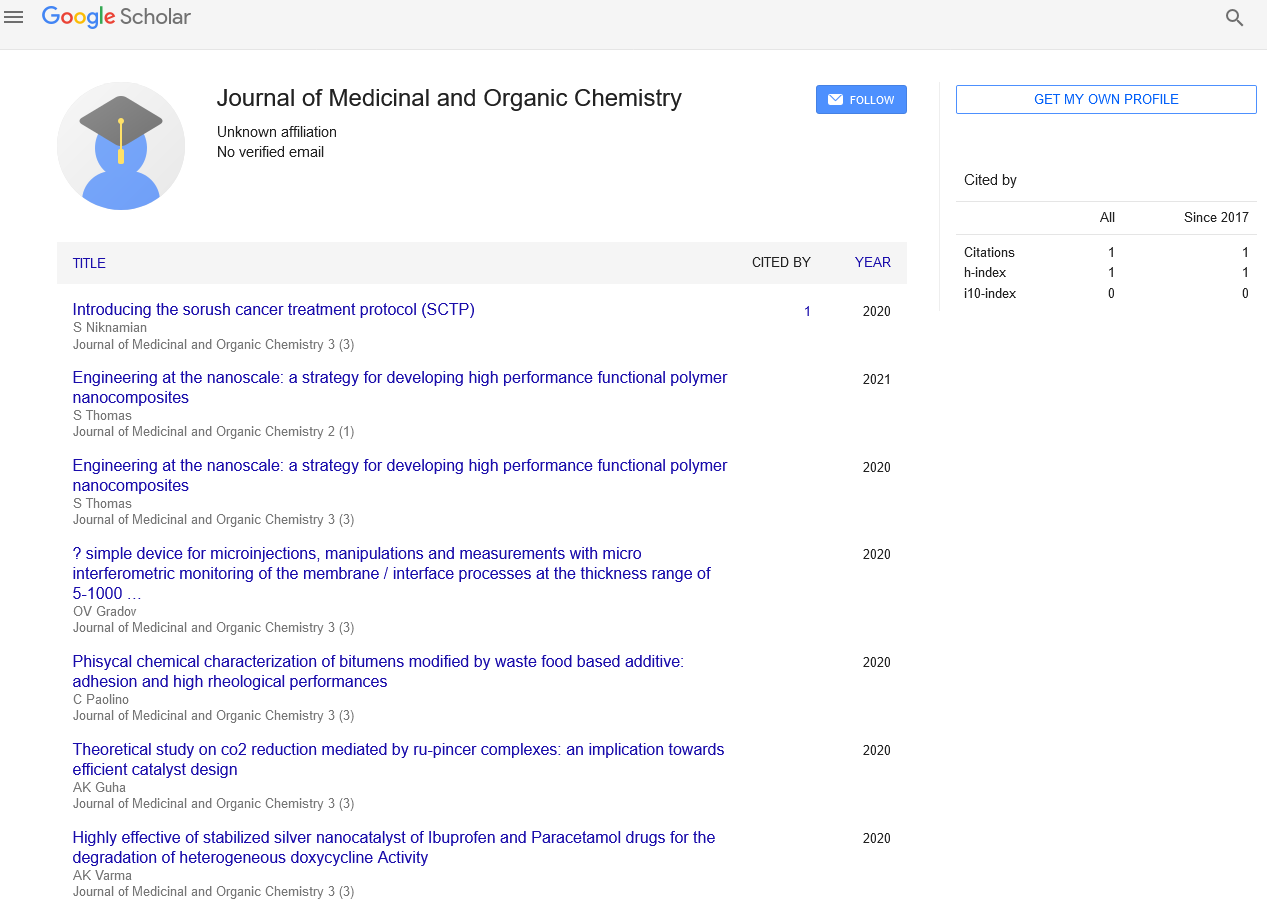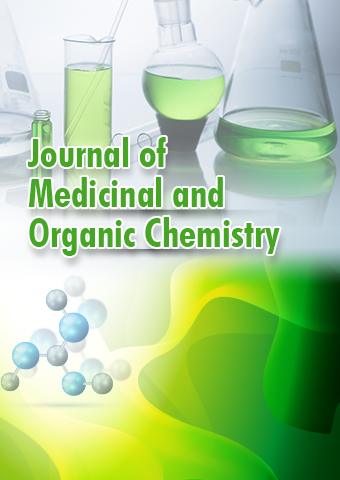Review Article - Journal of Medicinal and Organic Chemistry (2023) Volume 6, Issue 3
Drug Metabolism: Unlocking the Mysteries of Drug Transformation within the Body
Dr. Ravindra Kumar Singh*
Department of Chemistry, University of R.K Science and technology, India
Department of Chemistry, University of R.K Science and technology, India
E-mail: ravindrakumar.S@gmail.com
Received: 02-June-2023, Manuscript No. jmoc-23-101940; Editor assigned: 05-June-2023, PreQC No. jmoc-23- 101940; Reviewed: 19-June-2023, QC No. jmoc-23-101940; Revised: 23- June-2023, Manuscript No. jmoc-23- 101940 (R); Published: 30-June-2023; DOI: 10.37532/jmoc.2023.6(3).50-53
Abstract
Drug metabolism plays a pivotal role in determining the fate of drugs within the human body. It encompasses a series of enzymatic reactions that convert administered drugs into metabolites, enabling their elimination from the body. This intricate process involves the interplay of drug-metabolizing enzymes, transporters, and various physiological factors that influence drug disposition and efficacy. This abstract provides an extensive overview of drug metabolism, emphasizing its significance in drug development, clinical practice, and pharmacokinetics. It explores the major enzymatic pathways involved in drug metabolism, highlighting the contributions of phase I and phase II enzymes in the biotransformation of drugs. Phase I metabolism involves oxidation, reduction, and hydrolysis reactions that primarily serve to increase the polarity of drugs. Cytochrome P450 enzymes, a superfamily of enzymes, are prominently involved in phase I reactions and are responsible for the majority of drug metabolism in humans. Drug metabolism is a complex process by which the human body transforms drugs and other foreign substances into metabolites, facilitating their elimination from the body. This crucial mechanism plays a significant role in determining the effectiveness, safety, and duration of action of medications. Drug metabolism occurs primarily in the liver, although other organs also contribute to the process. The enzymatic reactions involved in drug metabolism can be categorized into Phase I and Phase II reactions. Phase I reactions involve the introduction or exposure of functional groups through oxidation, reduction, or hydrolysis reactions, primarily mediated by cytochrome P450 enzymes. Phase II reactions involve the conjugation of drugs or their Phase I metabolites with endogenous molecules, such as glucuronic acid, sulfate, glutathione, or amino acids. These conjugation reactions increase the water solubility of drugs, facilitating their excretion. Understanding drug metabolism is crucial for optimizing drug efficacy, determining dosing regimens, and predicting potential drug-drug interactions. Furthermore, the study of drug metabolism has implications for personalized medicine and the development of safer and more effective medications.
Keywords
Drug metabolism • Phase I metabolism • Phase II metabolism • Drugmetabolizing enzymes • Drug transporters pharmacogenomics • Personalized medicine • Pharmacokinetics • Drug-drug interactions• Adverse drug reactions
Introduction
Drug metabolism refers to the biochemical processes that occur within an organism to convert drugs into more water-soluble and easily excretable substances. These processes are vital for determining the pharmacokinetic properties, efficacy, and safety of drugs in the human body [1]. Drug metabolism plays a significant role in drug development, therapeutic drug monitoring, and understanding drug-drug interactions. When a drug is administered, it undergoes various metabolic transformations, primarily in the liver, although other organs such as the kidneys, intestines, lungs, and skin can also contribute. The liver is the main site of drug metabolism due to its high concentration of enzymes responsible for catalyzing these reactions. However, drug metabolism can occur in other tissues and cells as well [2]. The process of drug metabolism involves two phases: Phase I and Phase II reactions. Phase I reactions involve the introduction or exposure of a functional group, such as hydroxylation, oxidation, reduction, or hydrolysis. These reactions often generate intermediate metabolites that are more reactive than the parent drug. Phase I reactions are primarily mediated by a large family of enzymes known as cytochrome P450 (CYP) enzymes, which are responsible for metabolizing a wide range of drugs. Drug metabolism is a complex process by which the body breaks down and eliminates foreign substances, specifically drugs, from the body. It is a crucial aspect of pharmacokinetics, which encompasses the absorption, distribution, metabolism, and excretion of drugs, collectively known as ADME. Understanding drug metabolism is essential in the field of pharmacology as it helps determine a drug’s efficacy, safety, and potential interactions with other drugs or substances [3].
The liver plays a central role in drug metabolism, although other organs such as the kidneys, lungs, and intestines also contribute to the process. The liver contains a variety of enzymes responsible for metabolizing drugs, with the cytochrome P450 (CYP) enzymes being the most well-known and extensively studied. The metabolism of drugs can be broadly categorized into two phases: Phase I and Phase II metabolism. Phase I metabolism involves chemical modifications that introduce or unmask functional groups on the drug molecule, making it more susceptible to further metabolism or excretion. The most common reactions in Phase I metabolism include oxidation, reduction, and hydrolysis. The cytochrome P450 enzymes, particularly the CYP3A4, CYP2D6, and CYP2C9 subfamilies, are responsible for the majority of Phase I reactions. These enzymes are highly polymorphic, meaning that genetic variations can influence their activity. This genetic variability can lead to differences in drug response and metabolism between individuals, contributing to the concept of personalized medicine. Oxidation reactions, catalyzed by the cytochrome P450 enzymes, involve the addition of an oxygen atom to the drug molecule [4]. This process can introduce or expose reactive sites, making the drug more amenable to conjugation reactions in Phase II metabolism. Reduction reactions involve the loss of an oxygen atom or the addition of hydrogen to the drug molecule, resulting in the formation of metabolites with altered properties. Hydrolysis reactions, another common Phase I pathway, involve the cleavage of chemical bonds through the addition of water molecules. This process can lead to the formation of smaller, more water-soluble metabolites that are easier to eliminate from the body. Following Phase I metabolism, drugs often undergo Phase II metabolism, also known as conjugation reactions. These reactions involve the attachment of a functional group to the drug molecule, typically through a covalent bond. This conjugation process further increases the water solubility of the drug, facilitating its elimination through the kidneys or bile [5]. The most common Phase II reactions include glucuronidation, sulfation, methylation, acetylation, and glutathione conjugation. Glucuronidation, catalyzed by the UDPglucuronosyltransferase (UGT) enzymes, involves the addition of a glucuronic acid molecule to the drug or its Phase I metabolite. This reaction is a major pathway for the elimination of many drugs and drug metabolites [6].
Drug metabolism refers to the enzymatic conversion of drugs and other xenobiotics (foreign substances) into metabolites, which are then eliminated from the body. These metabolic transformations primarily occur in the liver, although other organs, such as the kidneys, lungs, and intestines, also contribute to the process [7].
The significance of drug metabolism
Drug metabolism serves several crucial purposes
Bioactivation: Some drugs are administered in an inactive form and require metabolic activation to exert their therapeutic effects. For example, prodrugs, which are pharmacologically inactive until metabolized, are designed to enhance drug delivery and reduce side effects.
Detoxification: Metabolism facilitates the elimination of drugs and xenobiotics from the body, preventing their accumulation and potential toxicity.
Elimination: Metabolites, resulting from drug metabolism, are generally more watersoluble and easily excreted from the body via urine or feces.
Influence on pharmacokinetics: Drug metabolism affects the pharmacokinetic properties of a drug, including its absorption, distribution, metabolism, and excretion (ADME). Understanding these parameters is essential for optimizing dosing regimens and ensuring therapeutic efficacy.
Mechanisms of drug metabolism
Drug metabolism occurs through two primary mechanisms: Phase I and Phase II metabolism.
Phase I metabolism
Phase I metabolism involves the introduction or exposure of a functional group (-OH, -NH2, -SH) through oxidation, reduction, or hydrolysis reactions. Cytochrome P450 (CYP) enzymes, found in high abundance in the liver, are the major catalysts of Phase I reactions. CYP enzymes exhibit a remarkable ability to metabolize a wide range of drugs and xenobiotics, making them crucial determinants of drug efficacy and safety [8].
Examples of phase I reactions include: In this process, the drug undergoes oxidative reactions mediated by CYP enzymes, resulting in the addition of oxygen to the molecule. This can lead to the formation of metabolites with increased polarity and reactivity.
Reduction: Some drugs are metabolized through reduction reactions, which involve the addition of electrons to the drug molecule [9]. This process often transforms drugs into inactive or less active metabolites.
Hydrolysis: Hydrolytic reactions involve the cleavage of chemical bonds in a drug molecule through the addition of water. This can lead to the formation of smaller metabolites that are more easily excreted.
Phase II Metabolism
Phase II metabolism involves the conjugation of drugs or their Phase I metabolites with endogenous molecules, such as glucuronic acid, sulfate, glutathione, or amino acids. These conjugation reactions increase the water solubility of the drug, facilitating its elimination from the body.
Examples of phase II reactions include: Glucuronidation: This is the most common Phase II reaction, where drugs are conjugated with glucuronic acid. Glucuronidation increases drug hydrophilicity, promoting renal excretion.
Sulfation: In sulfation reactions, drugs are conjugated with sulfate groups, resulting in more water-soluble metabolites that are readily eliminated.
Drug metabolism is a fascinating and essential process that significantly influences the fate of drugs within the human body. Through the enzymatic reactions of Phase I and Phase II metabolism, drugs are transformed into metabolites that are more easily eliminated from the body [10]. This process not only facilitates detoxification but also plays a vital role in determining the pharmacokinetics, efficacy, and safety of medications.
Conclusion
The intricate network of enzymes, particularly the cytochrome P450 enzymes, involved in drug metabolism highlights the complexity of this process. Variations in enzyme activity and expression levels can result in interindividual variability in drug response, leading to differences in therapeutic outcomes and potential drug-drug interactions. Understanding these variations is crucial for personalized medicine, where treatment plans can be tailored based on an individual’s unique metabolic profile. Advancements in the field of drug metabolism have contributed to the development of prodrugs, which rely on metabolic activation to unleash their therapeutic potential. This approach has improved drug delivery and minimized side effects, thereby enhancing patient compliance and treatment efficacy.
Drug metabolism is a complex and dynamic process that plays a pivotal role in the fate and effects of drugs within the human body. Its impact extends beyond basic drug elimination, influencing drug efficacy, safety, and personalized medicine. Further research in drug metabolism will continue to enhance our understanding of drug actions, lead to the development of improved therapeutics, and contribute to better patient outcomes.
References
- Petek BJ, Loggers ET, Pollack SM et al. Trabectedin in soft tissue sarcomas. Marine Drugs. 13, 974-83 (2015).
- Adams DD. autoimmune destruction of pericytes as the cause of diabetic retinopathy. Clinical Ophthalmology. 2, 295-298 (2008).
- Huang ES, Brown SE, Ewigman BG et al. (2007) Patient perceptions of quality of life with diabetes-related complications and treatments. Diabetes Care. 30, 2478-2483.
- Buehler AM, Cavalcanti AB, Berwanger O et al. Effect of tight blood glucose control versus conventional control in patients with type 2 diabetes mellitus: a systematic review with meta-analysis of randomized controlled trials. Cardiovascular Therapeutics. 31, 147-160 (2013).
- Mamdouh N, Khattab A. YOLO-based deep learning framework for olive fruit fly detection and counting. IEEE Access. 9, 84252-8426 (2021).
- Brunelli D, Polonelli T, Benini L. Ultra-low energy pest detection for smart agriculture. IEEE Sens J. 1-4 (2020).
- Mamdouh N, Khattab A. YOLO-based deep learning framework for olive fruit fly detection and counting. IEEE Access. 9, 84252-8426 (2021).
- Brunelli D, Polonelli T, Benini L. Ultra-low energy pest detection for smart agriculture. IEEE Sens J. 1-4 (2020).
- Goyal M. Endovascular thrombectomy after large vessel ischaemic stroke: a meta- analysis of individual patient data from five randomised trials. Lancet. 22, 416-430 (2016).
- Jackson Peter. The multiple ontologies of freshness in the UK and Portuguese agri‐food sectors. Trans Inst Br Geogr. 44, 79-93 (2019).
Indexed at, Google Scholar, Crossref
Indexed at, Google Scholar, Crossref
Indexed at, Google Scholar, Crossref
Indexed at, Google Scholar, Crossref

